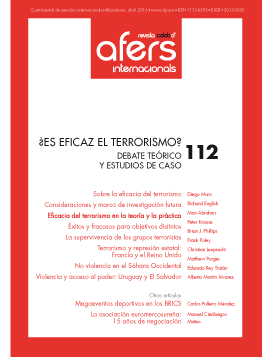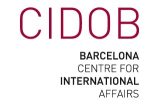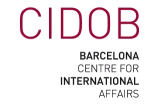¿Qué explica la supervivencia de los grupos terroristas? Alianzas y competencia
Palabras clave:
grupos terroristas, supervivencia organizativa, alianzas, competencia, longevidadResumen
Revista CIDOB d’Afers Internacionals, nº 112
Cuatrimestral (enero-abril 2016)
ISSN:1133-6595 | E-ISSN:2013-035X
DOI: https://doi.org/10.24241/rcai.2016.112.1.99
¿Por qué algunos grupos terroristas perduran más que otros? ¿Qué nos revela esta longevidad sobre la eficacia de las organizaciones terroristas? Este artículo examina, en primer lugar, por qué la supervivencia organizativa puede considerarse un factor de eficacia organizativa. En segundo lugar, se revisa la literatura sobre la longevidad de los grupos terroristas –incluyendo el examen sistemático de diez estudios cuantitativos sobre este tema. El análisis muestra que unos pocos factores están asociados a la longevidad recurrentemente –entre ellos, el tamaño del grupo y la participación en alianzas de grupos terroristas. En tercer lugar, y dado el interés teórico por las relaciones interorganizativas, se toman en consideración argumentos para explicar por qué las alianzas de grupos terroristas, y también la competencia entre grupos, probablemente contribuyen a la longevidad del grupo. Por último, se ofrecen sugerencias para avanzar en la investigación sobre esta temática.
Citas
Abrahms, Max. «What terrorists really want: Terrorist motives and counterterrorism strategy». International Security, vol. 32, n.º 4 (primavera de 2008), p. 78-105.
Al Jazeera. «Lebanon car bomb kills Hezbollah leader». Aljazeera (17 de marzo de 2014).
Asal, Victor y Rethemeyer, R. Karl. «The Nature of the Beast: Organizational Structures and the Lethality of Terrorist Attacks». The Journal of Politics, vol. 70, n.º 2 (2008), p. 437-449.
Asal, Victor; De la Calle, Luis; Findley, Michael y Young, Joseph. «Killing Civilians or Holding Territory? How to Think about Terrorism». International Studies Review, vol. 14, n.º 3 (2012), p. 475-497.
Bacon, Tricia. «Hurdles to International Terrorist Alliances: Lessons From al Qaeda’s Experience». Terrorism and Political Violence (febrero de 2015) (en línea) http://dx.doi.org/10.1080/09546553.2014.993466
Bakke, Kristin M.; Cunningham, Kathleen Gallagher y Seymour, Lee JM. «A Plague of Initials: Fragmentation, Cohesion, and Infighting in Civil Wars». Perspectives on Politics, vol. 10, n.º 2 (2012), p. 265-283.
Bapat, Navin A. y Bond, Kanisha D. «Alliances Between Militant Groups». British Journal of Political Science, vol. 42, n.º 4 (2012), p. 793-824.
Barnett, William P. y Hansen, Morten T. «The red queen in organizational evolution». Strategic Management Journal, vol. 17, n.º especial (1996), p. 139-157.
Baum, Joel A. C. y Oliver, Christine. «Institutional Linkages and Organizational Mortality». Administrative Science Quarterly, vol. 36 (1991), p. 187-218.
Berti, Benedetta. «Colombia’s FARC and the Basque ETA: Exploring the Tactical and Economic Partnership». Terrorism Monitor, vol. 7, n.º 2 (2009) (en línea) http://www.jamestown.org/single/?no_cache=1&tx_ttnews[tt_news]=34404
Blomberg, Brock; Engel, Rozlyn y Sawyer, Reid. «On the Duration and Sustainability of Transnational Terrorist Organizations». Journal of Conflict Resolution, vol. 54, n.º 2 (2010), p. 303-330.
Blomberg, Brock; Gaibulloev, Khusrav y Sandler, Todd. «Terrorist group survival: ideology, tactics, and base of operations». Public Choice, vol. 149, n.º 3/4 (2011), p. 441-463.
Bloom, Mia. «Palestinian Suicide Bombing: Public Support, Market Share, and Outbidding». Political Science Quarterly, vol. 119, n.º 1 (2004), p. 61-88.
Bloom, Mia. Dying to Kill: The Allure of Suicide Terrorism. Nueva York: Columbia University Press, 2005.
Bueno de Mesquita, Ethan. «The Quality of Terror». American Journal of Political Science, vol. 49, n.º 3 (2005), p. 515-530.
Carter, David B. «A Blessing or a Curse? State Support for Terrorist Groups». International Organization, vol. 66, n.º 01 (2012), p. 129-151.
Chenoweth, Erica. «Democratic Competition and Terrorist Activity». Journal of Politics, vol. 72, n.º 1 (2010), p. 16-30.
Chenoweth, Erica. «Terrorism and democracy». Annual Review of Political Science, vol. 16, (2013), p. 355-378.
Christia, Fotini. Alliance Formation in Civil Wars. Cambridge: Cambridge University Press, 2012.
Conrad, Justin y Greene, Kevin. «Competition, Differentiation, and the Severity of Terrorist Attacks». The Journal of Politics, vol. 77, n.º 2 (2015), p. 546-561.
Crenshaw, Martha. «The Causes of Terrorism». Comparative Politics, vol. 13, n.º 4 (1981), p. 379-399.
Crenshaw, Martha. «An Organizational Approach to the Analysis of Political Terrorism». Orbis, vol. 29, n.º 3 (1985), p. 465-489.
Crenshaw, Martha. «Theories of Terrorism: Instrumental and Organizational Approaches» Journal of Strategic Studies, vol. 10, n.º 4 (1987), p. 13-31.
Crenshaw, Martha. «How Terrorism Declines». Terrorism and Political Violence, vol. 3, n.º 1 (1991), p. 69-87.
Cress, Daniel M. y Snow, David A. «Mobilization at the margins: Resources, benefactors, and the viability of homeless social movement organizations». American Sociological Review, vol. 61, n.º 6 (1996), p. 1.089-1.109.
Cronin, Audrey Kurth. «How al-Qaida ends: The decline and demise of terrorist groups». International Security, vol. 31, n.º 1 (2006), p. 7-48.
Cronin, Audrey Kurth. How Terrorism Ends: Understanding the Decline and Demise of Terrorist Campaigns. Princeton: Princeton University Press, 2009.
Crossan, Mary M.; Lane Henry W. y White, Roderick E. «An Organizational Learning Framework: From Intuition to Institution». Academy of Management Review, vol. 24, n.º 3 (1999), p. 522-537.
Cunningham, David E. «Veto Players and Civil War Duration». American Journal of Political Science, vol. 50, n.º 4 (2006), p. 875-892.
Daxecker, Ursula E. y Hess, Michael L. «Repression hurts: coercive government responses and the demise of terrorist campaigns». British Journal of Political Political Science, vol. 43, n.º 03 (2013), p. 559-577.
De la Calle, Luis y Sánchez-Cuenca, Ignacio. «What we talk about when we talk about terrorism». Politics & Society, vol. 39, n.º 3 (2011), p. 451-472.
Della Porta, Donatella. Social movements, political violence, and the state: A comparative analysis of Italy and Germany. Cambridge: Cambridge University Press, 1995.
Della Porta, Donatella. Clandestine Political Violence Cambridge: Cambridge University Press, 2013.
Dettmer, J. «Fears of “Loyalist” Murder Missions; Northern Ireland». The Times (16 de febrero de 1989).
Enders, Walter y Sandler, Todd. «The Effectiveness of Anti-terrorism Policies: A Vector-autoregression-intervention Analysis». American Political Science Review, vol. 87, n.º 4 (1993), p. 829-844
Enders, Walter y Sandler, Todd. The Political Economy of Terrorism. Cambridge: Cambridge University Press, 2012.
Findley, Michael G. y Young, Joseph K. «More Combatant Groups, More Terror? Empirical Tests of an Outbidding Logic». Terrorism and Political Violence, vol. 24, n.º 5 (2012), p. 706-721.
Gaibulloev, Khusrav y Sandler, Todd. «Determinants of the demise of terrorist organizations». Southern Economic Journal, vol. 79, n.º 4 (2013), p. 774-792.
Gaibulloev, Khusrav y Sandler, Todd. «An Empirical Analysis of Alternative Ways that Terrorist Groups End». Public Choice, vol. 160, n.º 1-2 (2014), p. 25-44.
Geroski, Paul A. «What Do We Know About Entry?» International Journal of Industrial Organization, vol. 13, n.º 4 (1995), p. 421-440.
Gillespie, Richard. «Political violence in Argentina: Guerrillas, Terrorists, and Carapintadas», en: Crenshaw, Marta (ed.). Terrorism in Context. Philadelphia: Pennsylvania State University Press, 1995, p. 211-248.
Halloran, Richard. «Latin Guerrillas Joining Forces, U.S. Officers Say». The New York Times, 3 de marzo de 1987.
Hannan, Michael T. y Freeman, John. «The Ecology of Organizational Mortality:American Labor Unions, 1836-1985». American Journal of Sociology, vol. 94, n.º 1 (1988), p. 25-52.
Hayes, Bernadette C. y McAllister, Ian. «Sowing Dragon’s Teeth: Public Support for Political Violence and Paramilitarism in Northern Ireland». Political Studies, vol. 49, n.º 5 (2001), p. 901-922.
Hoffman, Bruce. Inside Terrorism. Nueva York: Columbia University Press, 2006.
Horowitz, Michael C. «Nonstate Actors and the Diffusion of Innovations: The Case of Suicide Terrorism». International Organization, vol. 64, n.º 1 (enero 2010), p. 33-64.
Horowitz, Michael C. y Potter, Philip B. K. «Allying to Kill: Terrorist Intergroup Cooperation and the Consequences for Lethality». Journal of
Conflict Resolution, vol. 58, n.º 2 (2014), p. 199-225.
Hubbard, Ben. «Al Qaeda Tries a New Tactic to Keep Power: Sharing It». The New York Times (9 de junio de 2015).
Humphreys, Macartan y Weinstein Jeremy M. «Handling and Manhandling Civilians in Civil War». American Political Science Review, vol. 100, n.º 3 (2006), p. 429-427.
Im, Eric I.; Cauley, Jon y Sandler, Todd. «Cycles and Substitutions in Terrorist Activities: A Spectral Approach». Kyklos, vol. 40, n.º 2 (1987), p. 238-255.
Jackson, Brian A; Baker John C.; Chalk, Peter; Cragin, Kim; Parachini, John y Trujillo, Horacio R. Aptitude for Destruction: Organizational Learning in Terrorist Groups and Its Implications for Combating Terrorism. Santa Monica: Rand Corporation, 2005.
Johnson, T. «Blast Yields Archives of Marxist Abduction Ring Hidden Chamber in Managua Offers Glimpse into Terrorism». Dallas Morning News (4 de julio de 1993).
Jones, Seth G. y Libicki, Martin C. How Terrorist Groups End: Lessons for Countering al Qa’ida. Santa Monica: Rand Corporation, 2008.
Karmon, Ely. Coalitions Between Terrorist Organizations: Revolutionaries, Nationalists and Islamists. Leiden. Leiden, Holanda y Boston, MA: Nijhoff Publishers, 2005.
Kenney, Michael. From Pablo to Osama: Trafficking and Terrorist Networks, Government Bureaucracies, and Competitive Adaptation. University Park, PA: Penn State University Press, 2007.
Krause, Peter. «The Political Effectiveness of Non-state Violence: A Two-level Framework to Transform a Deceptive Debate». Security Studies, vol. 22, n.º 2 (2013), p. 259-294.
Kydd, Andrew y Walter, Barbara F. «Sabotaging the Peace: The Politics of Extremist Violence». International Organization, vol. 56, n.º 2 (primavera 2002), p. 263-296.
Lichbach, Mark Irving. The Rebel’s Dilemma. Michigan: University of Michigan Press, 1995.
Lister, Charles. «Why Assad is Losing». Foreign Policy, 5 de mayo de 2015a.
Lister, Charles. The Islamic State: A Brief Introduction. Washington, D.C.: Brookings, 2015b.
Lister, Tim y Razek, Raja. «Islamist rivals in Syria find a common enemy in “crusaders” coalition». CNN (6 de octubre de 2014).
McAdam, Doug. «Conceptual Origins, Current Problems, Future Directions», en: McAdam, Doug; McCarthy, John D. y Zald, Mayer N. (eds.).
Comparative Perspectives on Social Movements: Political Opportunities, Mobilizing Structures, and Cultural Framings. Cambridge: Cambridge University Press, 1996, p. 23-40.
McCauley, Clark. «Jujitsu Politics: Terrorism and Responses to Terrorism», en: Kimmel, Paul R. y Stout, Chris E. (ed.). Collateral Damage: The Psychological Consequences of America’s War on Terrorism. Westport: Praeger, 2006, p. 45-66.
McKittrick, David y McVea, David. Making Sense of the Troubles. Belfast: Blackstaff, 2000.
Mendelsohn, Barak. «Al-Qaeda’s Franchising Strategy». Survival, vol. 53, n.º 3 (2011) p. 29-50.
Merton, Robert K. «Bureaucratic structure and personality». Social Forces, vol. 18, n.º 4 (1940), p. 560-568.
Moghadam, Assaf. «Terrorist Affiliations in Context: A Typology of Terrorist Intergroup Cooperation». CTC Sentinel, vol. 8, n.º 3 (2015), p. 22-25.
Nemeth, Stephen. «The Effect of Competition on Terrorist Group Operations». Journal of Conflict Resolution, vol. 58, n.º 2 (2014), p. 336-362.
Owen, Richard, y Evans, Michael. «Bases on Alert as IRA Links Emerge». The Times (5 de mayo de 1988).
Pearlman, Wendy. «Spoiling Inside and Out: Internal Political Contestation and the Middle East Peace Process». International Security, vol. 33, n.º 3 (2009), p. 79-109.
Pearson, Frederic; Akbulut, Isil y Lounsbery, Mary O. «Group Structure and Intergroup Relations in Global Terror Networks: Further
Explorations». Terrorism and Political Violence (2015) (en línea) http://dx.doi.org/10.1080/09546553.2015.1058788
Phillips, Brian J. «Terrorist Group Cooperation and Longevity». International Studies Quarterly, vol. 58, n.º 2 (2014), p. 336-347.
Phillips, Brian J. «Enemies with Benefits? Violent Rivalry and Terrorist Group Longevity». Journal of Peace Research, vol. 52, n.º 1 (2015a), p. 62-75.
Phillips, Brian J. «What is a Terrorist Group? Conceptual Issues and Empirical Implications». Terrorism and Political Violence, vol. 27, n.º 2 (2015b), p.225-242.
Pope, Hugh. «Turkey’s rights record criticised». Independent, 9 de julio de 2011. http://www.independent.co.uk/news/ world/europe/turkeys-rights-record-criticised-1532053.html
Porter, Michael E. Competitive Advantage: Creating and Sustaining Superior Performance. Nueva York: Free Press, 1985.
Post, Jerrold. «Rewarding Fire with Fire: Effects of Retaliation on Terrorist Group Dynamics». Studies in Conflict and Terrorism, vol. 10, n.º 1 (1987), p. 23-35.
Price, Brian C. «Targeting Top Terrorists: How Leadership Decapitation Contributes to Counterterrorism». International Security, vol. 36, n.º 4 (2012), p. 9-46.
Rapoport, David C. «Terrorism», en: Hawkesworth, Mary y Kogan, Maurice (eds.). Encyclopedia of Government and Politics, Vol. 2. Londres: Routledge, 1992, p. 1.061-1.079.
Reinares, Fernando y Alonso, Rogelio. «Confronting Ethnonationalist Terrorism in Spain: Political and Coercive Measures Against ETA», en: Art, Robert J. y Richardson, Louise (eds.). Democracy and Counterterrorism: Lessons from the Past. Washington, DC: United States Institute of Peace Press, 2007, p. 105-132.
Roggio, Bill. «IMU involved in suicide assault on Karachi airport». Long War Journal, 11 de junio de 2014.
Romero, Mauricio. Paramilitares y Autodefensas 1982-2003. Bogotá: Universidad Nacional de Colombia, 2003.
Ross, Jeffrey I. y Gurr, Ted R. «Why Terrorism Subsides: A Comparative Study of Canada and the United States». Comparative Politics, vol. 21, n.º 4 (1989), p. 405-426.
Seper, Jerry. «Colombian General says IRA Training Guerrillas». Washington Times, 25 de abril de 2002.
Shapiro, Jacob N. The Terrorist’s Dilemma: Managing Violent Covert Organizations. Princeton, NJ: Princeton University Press, 2013.
Simon, Herbert A. «On the concept of organizational goal». Administrative science quarterly, vol. 9, n.º 1 (1964), p. 1-22.
Staniland, Paul. «Between a Rock and a Hard Place: Insurgent Fratricide, Ethnic Defection, and the Rise of Pro-state Paramilitaries». Journal of Conflict Resolution, vol. 56, n.º 1 (2012), p. 16-40.
Stedman, Stephen. «Spoiler Problems in Peace Processes». International Security, vol. 22, n.º 2 (1997), p. 5-53.
Stegmaier, Mary y Klára Vlachová. «The endurance of the Czech communist party». Politics & Policy, vol. 37, n.º 4 (2009), p. 799-820.
Tankel, Stephen. «Lashkar-e-Taiba: From 9/11 to Mumbai». Developments in Radicalisation and Political Violence, Working paper series, The International Centre for the Study of Radicalisation and Political Violence, King’s College London, 2009.
Taylor, Peter. Loyalists. Londres: Bloomsbury, 1999.
The Daily Star. «Kahwagi: Army will do utmost to free hostages», 12 de agosto de 2014.
The Guardian. «Bar Gunmen ‘May Launch Murder Wave’: Leads Link Killers to UVF», 17 de mayo de 1988.
Vittori, Jodi. «All Struggles Must End: The Longevity of Terrorist Groups». Contemporary Security Policy, vol. 30, n.º 3 (2009), p. 444-466.
Wagner, Joachim. «Exports, Imports and Firm Survival: First evidence for manufacturing enterprises in Germany». Review of World Economics, vol. 149, n.º 1 (2013), p. 113-130.
Waltz, Kenneth. Theory of International Politics. Nueva York: McGraw Hill, 1979.
Weinberg, Leonard. The End of Terrorism? Nueva York: Routledge, 2012.
Weinstein, Jeremy. Inside Rebellion: The Politics of Insurgent Violence. Nueva York: Cambridge University Press, 2007.
Wiewel, Wim y Hunter, Albert. «The Interorganizational Network as a Resource: A Comparative Case Study on Organizational Genesis». Administrative Science Quarterly, vol. 30, n.º 4 (1985), p. 482- 496.
Wilson, James Q. Political Organizations. Princeton, NJ: Princeton University Press, 1974.
Woodworth, Paddy. Dirty War, Clean Hands: ETA, the GAL and Spanish Democracy. New Haven: Yale University Press, 2002.
Young, Joseph K. y Dugan, Laura. «Survival of the Fittest: Why Terrorist Groups Endure». Perspectives on Terrorism, vol. 8, n.º 2 (2014), p. 2-23.












